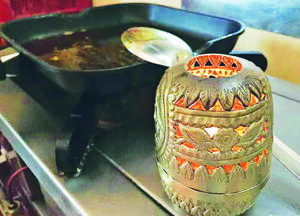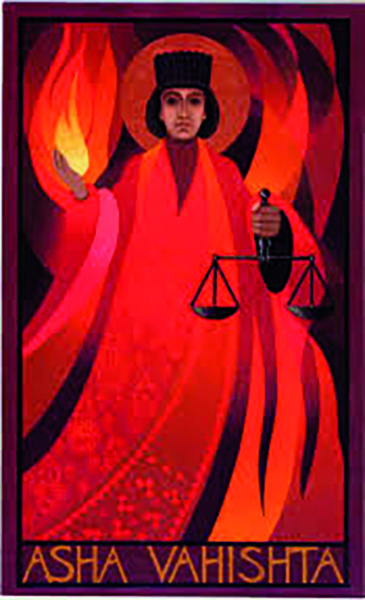 Today, 14th September, 2024, is Roj Hormuzd of Mah Ardibehesht – literally and figuratively, the day dedicated to the Divine Creator and the Divine Order of the Created Universe. In the Avesta, Ardibehesht is referred to as Asha Vahishta. Asha is variously translated as Truth, Righteousness and Divine Order. Vahishta means ‘the Best’. Ardibehesht embodies Ahura Mazda’s Truth, Righteousness and the Divine Order, with which Ahura Mazda created and sustains the Universe.
Today, 14th September, 2024, is Roj Hormuzd of Mah Ardibehesht – literally and figuratively, the day dedicated to the Divine Creator and the Divine Order of the Created Universe. In the Avesta, Ardibehesht is referred to as Asha Vahishta. Asha is variously translated as Truth, Righteousness and Divine Order. Vahishta means ‘the Best’. Ardibehesht embodies Ahura Mazda’s Truth, Righteousness and the Divine Order, with which Ahura Mazda created and sustains the Universe.
Interestingly, the first month of the Zoroastrian calendar is Fravardin, dedicated to Fravashi or Fravahar, the prototype of all creation and the second month is Ardibehesht, which celebrates the Creator’s Truth, Righteous or Divine Order and Healing.
The Divinity of Fire
Ardibehesht is an Amshaspand (Archangel) or Amesha Spenta (Bounteous Immortal) presiding over the energy of fire while Adar Yazad is a Hamkara or helper of Ardibehesht. This is why many Indian fire temples were consecrated in this month, the most notable being the Anjuman Atash Behram (consecrated on Roj Ardibehesht of Mah Ardibehesht (1897) and the Navsari Atash Behram, consecrated on Roj Sarosh of Mah Ardibehesht (1765).
In ancient times, whenever a Zoroastrian built or acquired a new home, he would arrange for a dedicated prayer room or corner before occupying the house, and arrange for fire or Ardibehesht to be brought home. The entire family would pray before this fire day and night. Bringing Ardibehesht home symbolically meant bringing home truth, righteousness and divine order.
Even today, when we light a diva (oil lamp) at home we should pray five Yatha and visualize ushering the energies of truth and righteousness in our lives and divine order in our homes. Ardibehesht is also a healing and life-giving force. Hence, keeping a live fire burning at home, even if just an oil lamp, means keeping the energy of life and good health, flowing at home.
Embodiment of Truth
Ardibehesht is the embodiment of God’s Truth, and in the Zoroastrian religion, truth is considered as the highest virtue. As per the Pahlavi texts, Rasti (truth) and Radhi (charity) go hand in hand. It is only through truth and righteousness that Ahura Mazda’s friendship can be attained. The ancient Greek historians had observed that every Zoroastrian child’s basic yet fundamental education began with emphasis on always speaking the truth.
In Sanskrit, there’s a term – Sat-Chit-Ananda, where Sat is Truth, absolute being or existence or that which is enduring and unchanging, Chit is Consciousness, understanding and comprehension and Ananda is Bliss, a state of pure happiness. To Hindus, Sat-Chit-Ananda is the source of all consciousness and all perfection. To experience Sat-Chit-Ananda is to achieve the ultimate goal of the spiritual journey. Similar to Sat-Chit-Ananda is Satyam (truth), Shivam (divinity), Sundaram (Beauty) – the mystical meaning being: when Truth is experienced, Divinity manifests out of that experience and Beauty becomes the flowering of consciousness of the person experiencing the Truth.
In the Hoshbam prayer, usually recited at dawn, we chant, “Asha vahishta, asha sraeshta, daresāma thwā, pairi thwā jamyāma, hamem thwā hakhma,” which means, “Through the best righteousness, excellent righteousness, O Ahura Mazda, may we catch sight of Thee and may we come near Thee and attain Thy eternal friendship.” This is an affirmation that every devout Zoroastrian makes at the start of day to earn friendship with Ahura Mazda by walking the path of Asha.
Healing Prayer
The Ardibehesht Yasht is one of the best prayers for healing all kinds of physical ailments. There is also an old healing tradition of ‘Ardibehesht ni Picchi’, where a priest or even a lay person, after a bath and performing the farazyat (obligatory) prayers, recites the Ardibehesht Yasht, running a clean white handkerchief or a clean muslin cloth from head to toe of the ailing person. It is a tried and tested Zoroastrian form of healing with a high degree of success.
In the Ardibehesht Yasht, we pray, “Ādim framraomi Ashem Vahishtem; yezī framraomi Ashem Vahishtem, āat anyaēsham Ameshanām Spentanām hvāyaonem; yim pāiti Mazdāo humatāish, yim pāiti Mazdāo hūkhtāish, yim pāiti Mazdāo hvarshtāish. Garō-nmānem Ahurahe hvāyaonem. Garō-nmānem nereyō asti ashāvaoyō. Naēchish dravatām ayene paitish garō-nmanem, ravohu ashāyonem chithrem Ahurem Mazdām.”
Translated, it means, “I like him (i.e. Ardibehesht); when I like Ardibehesht, then (he) of (all) other Ameshāspands (becomes) a helper, whom (the Creator) Ahura Mazda nourishes with good thoughts, good words, and good actions. The Garothmān (Paradise), Ahura Mazda’s own abode, is for righteous persons.” The essence of this verse is that only a righteous person can be in the abode or presence of Ahura Mazda.
Five Types Of Healers
The Ardibehesht Yasht also refers to five types of healers: “Ashō-baēshazō, dātō-baeshazō, karetō-baēshazō, urvarōbaēshazō, mānthrō-baēshazō; baēshazanām baēshazyōtemō yat mānthrem-spentem-baēshazyō; yō narsh ashaonō hacha uruthwān baēshzyāt, aeshō zī asti baēshazanām baēshazyōtemō” or “One who heals by means of purification rites or through his own Ashoi or piety (Ashō-baēshazō), one who cures (social ills) by law and justice (dātō-baeshazō), one who heals with the knife like a surgeon (karetō-baēshazō), one who restores health by means of herbs and vegetation (urvarōbaēshazō), and one who heals by means of reciting the mānthra or prayers (mānthrō-baēshazō)”. The Yasht affirms that the “best among healers is the one who heals reciting the mānthra”.
Nirang Of Ardibehesht
The Nirang of Ardibehesht is a very powerful capsule prayer which should be recited three times after the recitation of Ardibehesht Yasht. “Dādāre jehādār tavānā O dānā, O parvartār O āfarīdegār, O kerfehgar, O avakhshīdār. Ahereman hīch, nādān, O natavānad ba hīch chīz nashahed. Ahura Mazda dādārī, ahereman marochīnīdārī. Dādār pāk, ahereman nāpāk; ahereman khāk shavad, ahereman dūr shavad, ahereman dafe shavad, ahereman shekasteh shavad, ahereman halāk shavad. Avval dīn Zarathushtī pāk; Ahura Mazda buland kavī, beh, awazūnī.” Which means, “The Creator, the keeper of the world, (is) omnipotent and omniscient, and the Nourisher of all, and the producer, and the Doer of meritorious deeds and overseer. Ahriman is nothing whatsoever (and is) ignorant, and cannot do anything. Hormazd (is) the Creator (and) Ahriman the destroyer. The Creator (is) Holy and Ahriman (is) wicked. May Ahriman perish, may Ahriman be far away, may Ahriman be vanished, may Ahriman be defeated and may Ahriman be overcome. The foremost Religion (is the) pure Zoroastrian (Religion); Hormazd (is) Exalted, Powerful, Good (and) the Increaser.”
Airyaman Isho
The Ardibehesht Yasht also refers to the prayer of Airyaman Isho, which is actually Yasna 54. It is very efficacious and powerful, and should be prayed after chanting Ardibehest Yasht and the Ardibehesht Nirang. Airyaman Yazad is a co-worker of Ardibehesht Ameshaspand and therefore, it is considered meritorious and beneficial to recite this manthra after the Ardibehesht Yasht. Yasna 54.1 should be recited four times. It has the power to drive away diseases, physical, mental as well as spiritual. Part of it is composed in the Gathic dialect and it is affirmed that this specific Yasna 54 will be recited at the time of the future restoration of the world.
One may invoke Airyaman Yazad every day. However, it is considered particularly meritorious to invoke this Yazata during the month of Ardibehesht and the Parab of Ardibehesht. This short but very efficacious prayer should be recited after reciting the Ardibehesht Yasht and its Nirang:
“Banaame yazade bakshaayandeh bakshaayazgar meherbaan,Yaanim mano, yaanim vacho, yaanim shyaothnem ashaono zarathushtrahe. Aa Airyemaa ishyo rafedhraai, jantu nerebyaschaa naairibyaschaa, zarathushtrahe vangheush rafedhraai manangho, yaa daenaa vairim hanaat mizdem, ashahyaa yaasaa ashim yaam ishyaam, Ahuro masataa mazdaao.”
The above verse should be recited four times followed by reciting the Ashem Vohu thrice and followed by reciting:
“Airyamanem ishim yazamaide, amavantem verethraajanem vitbaeshanghem, majishtahe ashahe sravanghhaam,
gaathaao spentaao ratukhshathraaoashaonish yazamaide, staota yasnya yazamaide, yaa daataa angheush pauruyehyaa. Yenghe haataam aat yesne paiti vangho, mazdaao ahuro vaethaa ashaat hachaa, yaaonghaamchaa taanschaa taaoschaa yazamaide.”
Conclude with reciting one Ashem Vohu!
May this Holy month of Ardibehesht increase faith and righteousness within our community! May there be good health and harmony enhanced through the healing powers of Ardibehesht and may there be peace, progress and prosperity through Asha, the Divine Order!
- Why Pray In A Language We Do Not Understand? - 29 March2025
- Celebrate Nature’s New Year With Purity And Piety of Ava - 22 March2025
- Celebrate Navruz 2025 With The Spirit Of Excellence And Wholesomeness - 15 March2025
